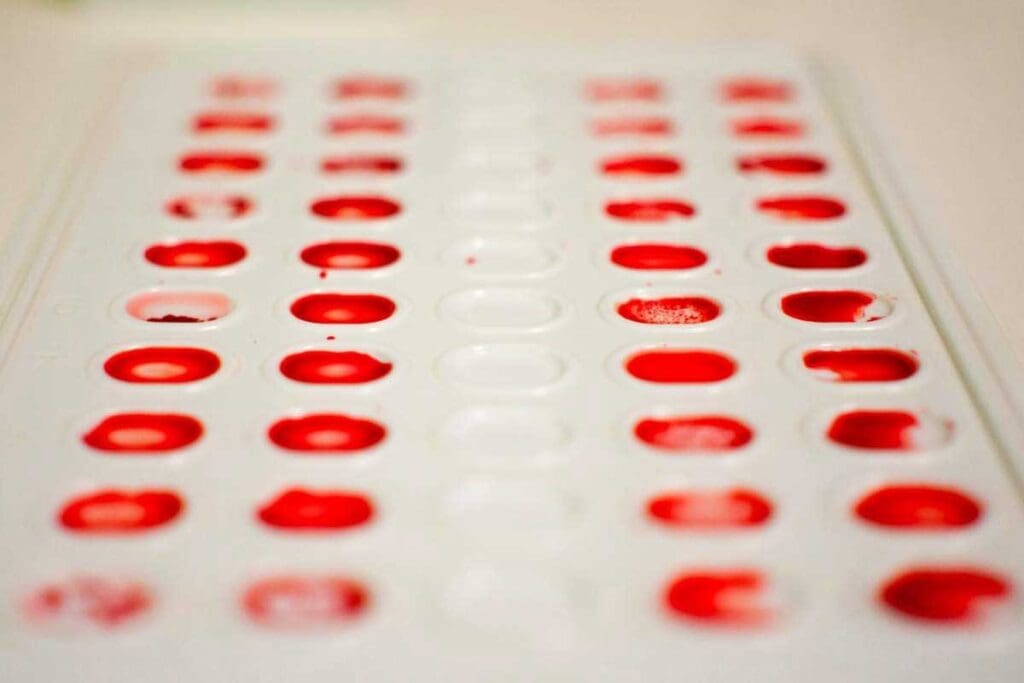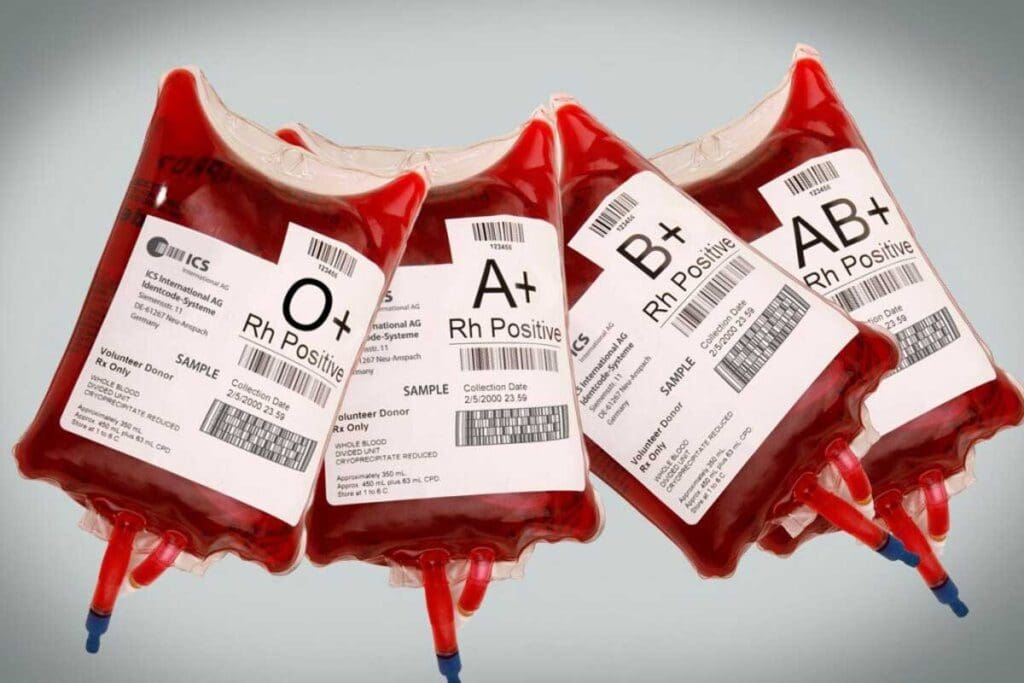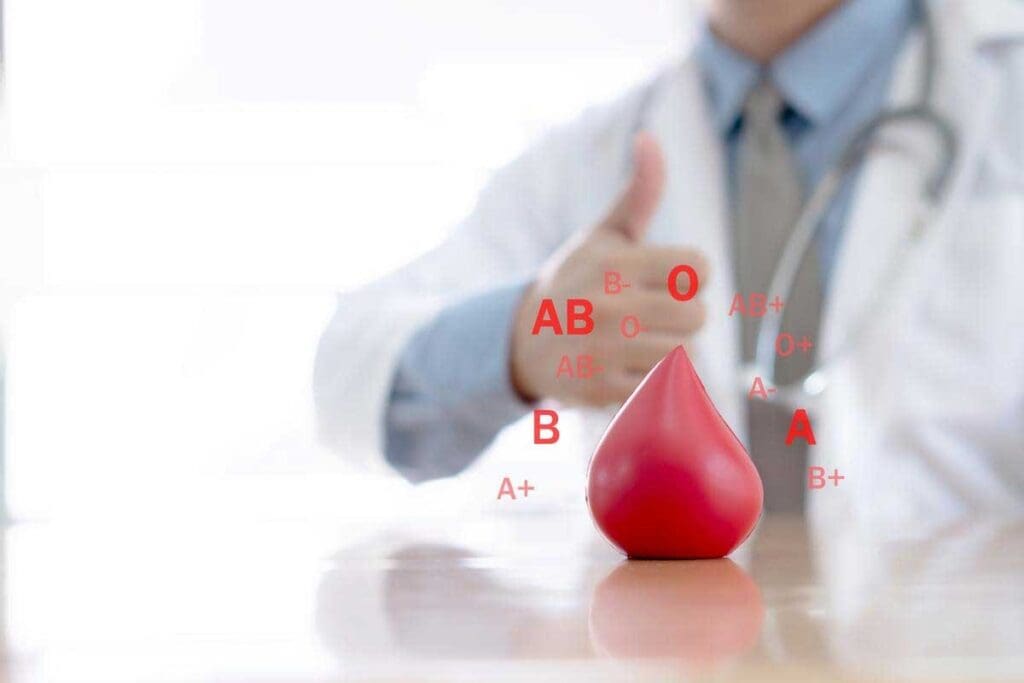Last Updated on November 17, 2025 by Ugurkan Demir
Knowing about blood types and how they match is key to safe blood transfusions. A blood donor chart is a vital tool. It helps doctors make the right choices for blood transfusions.

There are four main blood groups based on two antigens, A and B, on red cells. The Rh factor adds another layer, making blood types positive or negative. This creates the 8 most common blood types.
The science of blood types is quite interesting. It shows how genetics and immune responses work together. Blood type is decided by certain antigens on red blood cells, thanks to genetics.

The ABO blood group system sorts blood into four types: A, B, AB, and O. This is based on A and B antigens on red blood cells. Our blood type comes from our parents, with each giving one ABO gene.
This gene mix decides our blood type. The A and B genes are strong, while O is weak. So, people with AA or AO have type A blood. Those with BB or BO have type B, and AB is AB. Type O comes from OO.
Knowing these rules helps us figure out who can safely get blood from whom.
Another key factor is the Rh factor. It’s a protein that can be there or not on red blood cells. If it’s there, you’re Rh-positive; without it, you’re Rh-negative. This matters a lot in blood transfusions.
The mix of ABO blood types and Rh factor gives us eight main types. These include A+, A-, B+, B-, AB+, AB-, O+, and O-. The right match is vital to avoid serious reactions.
A blood donor chart is key for matching donors with recipients. It’s important for safe blood transfusions.
There are two main parts to blood transfusion compatibility. These are red blood cell and plasma donation. We’ll look at both to see how charts help make transfusions safe.
Red blood cell compatibility depends on blood type (A, B, AB, or O) and the Rh factor (positive or negative). People with O negative blood can donate to anyone because their blood is universal.
The Rh factor is also important. Rh-negative blood goes to Rh-negative patients. Rh-positive patients can get either Rh-positive or Rh-negative blood.
Plasma donations have different rules. AB plasma is universal because it doesn’t have antibodies against A or B antigens. This makes it safe for all blood types.
Knowing these rules is essential for doctors to ensure safe transfusions.

In conclusion, a blood donor chart is a critical tool. It helps doctors match blood types for safe transfusions.
Knowing how blood types are spread out is key for managing blood supplies in America. Different ethnic groups have different blood types. This is important for blood transfusions.
In the US, O positive is the most common blood type, with A positive close behind. But, the spread of blood types isn’t the same for everyone. For example, about 45 percent of Caucasians are type O. But, 51 percent of African-Americans and 57 percent of Hispanics are also type O.
The top blood types in the US are O positive and A positive. O-negative blood stands out because it can be given to anyone. This makes it very useful in emergencies.
Here’s a quick look at who gets what:
While O negative is the go-to for emergencies, some blood types are much rarer. AB negative is one of the rarest, found in less than 1% of Americans.
Rare blood types are important because they can cause bad reactions if not matched right. So, knowing about these rare types is vital for keeping patients safe.
| Blood Type | Frequency in US Population | Clinical Significance |
| O negative | around 7% | Universal donor for red cells |
| AB negative | less than 1% | Rare, requires careful matching |
The idea of universal donors and recipients is key for safe blood transfusions. Universal donors can give blood to anyone, while universal recipients can get blood from anyone.
O-negative blood is the universal donor for red cells. It has no A or B antigens, making it safe for all blood types. This is very important in emergencies when we don’t know the patient’s blood type.
O negative donors are very important. Their blood can be used in emergencies, surgeries, and for patients with unknown blood types.
O positive blood is versatile but not universal. It has the RhD antigen, which can cause problems for RhD-negative people.
So, O-negative blood is the best for universal red cell donations. It works for both RhD positive and negative patients.
AB plasma is the universal plasma donor. It has no A or B antibodies, making it safe for all blood types.
This makes AB plasma very useful for plasma transfusions. It won’t cause a reaction because of ABO incompatibility.
O negative donors are universal, but O negative recipients are not. They can only get O negative blood to avoid a bad reaction.
Healthcare providers must be careful with blood transfusions. They need to make sure O negative recipients get the right blood.
In summary, knowing about universal donors and recipients is vital for safe blood transfusions. By understanding O-negative and AB plasma donors, we can better manage blood supplies. This helps meet the needs of patients needing transfusions.
Sorting blood into groups is key for matching donations with recipients. These systems help us understand the variety of blood types. They make sure the blood given is safe for the person receiving it.
The most common system groups blood into four types: Type 1 (O), Type 2 (A), Type 3 (B), and Type 4 (AB). It’s based on certain antigens on red blood cells. The ABO blood group system is vital in transfusion medicine, as it checks if blood is compatible.
The ABO system works like this:
Some blood types are more common than others globally. The most common blood type worldwide is Type 2 (A), followed by Type 1 (O). The spread of blood types is influenced by genetics, which differ among populations.
| Blood Type | Approximate Global Distribution |
| Type 1 (O) | 45% |
| Type 2 (A) | 40% |
| Type 3 (B) | 10% |
| Type 4 (AB) | 5% |
There are over 300 known antigens that create “rare blood types.” Some blood types are found only in certain ethnic or racial groups. International networks are key in sharing rare blood types, helping patients with rare types get the right blood.
These networks need detailed records and teamwork between blood banks and transfusion services worldwide. Together, they make sure patients get the right blood, no matter how rare it is.
We’ve looked into the facts about blood types, donation, and matching. Blood donor charts are key in healthcare. They make sure blood transfusions are safe, which is vital for patients.
Liv Hospital uses these charts for the latest care methods. This ensures top-notch care for patients. Knowing about blood types helps doctors give the best care.
Blood types are different because of unique blood characteristics. Blood donor charts help match blood for patients. They are vital for top medical care.
A person’s blood type is based on certain antigens on their red blood cells. It also depends on their Rh factor. This factor makes blood positive or negative.
O-negative blood is special because it can be given to anyone. It doesn’t have A or B antigens on its surface.
No, O+ is not a universal donor. It has the Rh positive factor. This can cause problems for Rh negative recipients.
AB- individuals can donate to AB- and AB+ blood types. Their plasma can be used by anyone with AB blood type.
In the US, O positive and A positive are often the most common blood types.
Blood type is determined by genetics. It affects the presence or absence of specific antigens on red blood cells. The Rh factor also plays a role.
The Rh factor is very important in transfusion medicine. It ensures that Rh-negative individuals don’t react to Rh-positive blood. Matching Rh factors is key to safe transfusions.
O-negative blood is the most versatile for red blood cell donations. AB plasma is considered the universal plasma donor type.
Blood group systems, like the ABO system, sort blood into types. They do this based on specific antigens on red blood cells.
Different blood types come from genetic variations. These variations affect the presence or absence of specific antigens on red blood cells. This is important for safe transfusions.
Jeon, Y. W., Lim, J. Y., & Kim, H. (2023). Blood transfusion reactions: pathophysiology, detection, and management — a comprehensive review. BMC Hematology & Transfusion Medicine, 9, 102. https://pmc.ncbi.nlm.nih.gov/articles/PMC9144124/
Subscribe to our e-newsletter to stay informed about the latest innovations in the world of health and exclusive offers!